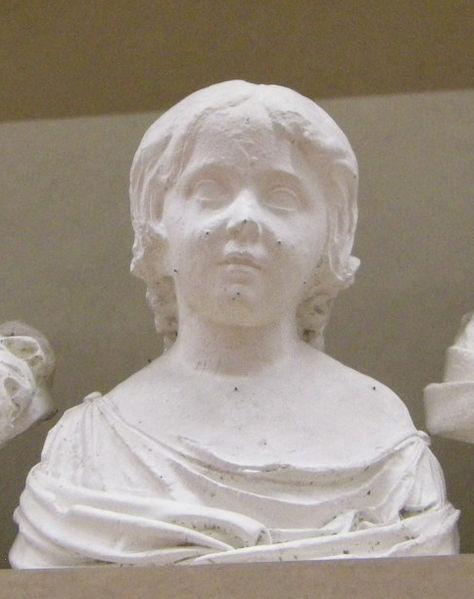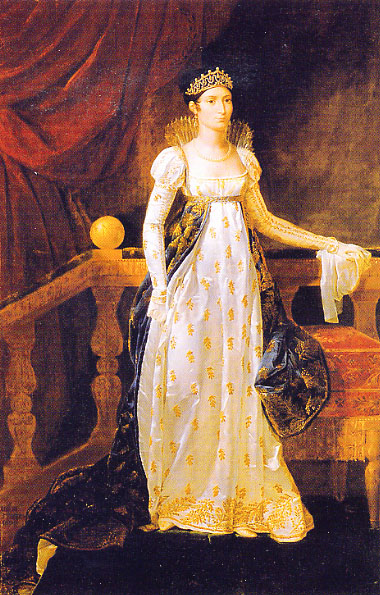<Back to Index>
- Philologist and Writer John Ronald Reuel Tolkien, 1892
- Painter and Physiologist Carl Gustav Carus, 1789
- Grand Duchess of Tuscany Maria Anna Elisa Bonaparte, 1777
PAGE SPONSOR
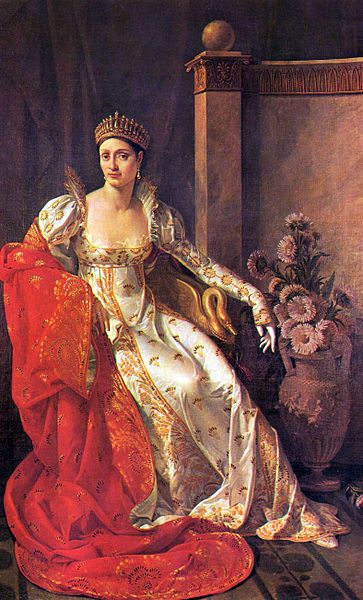
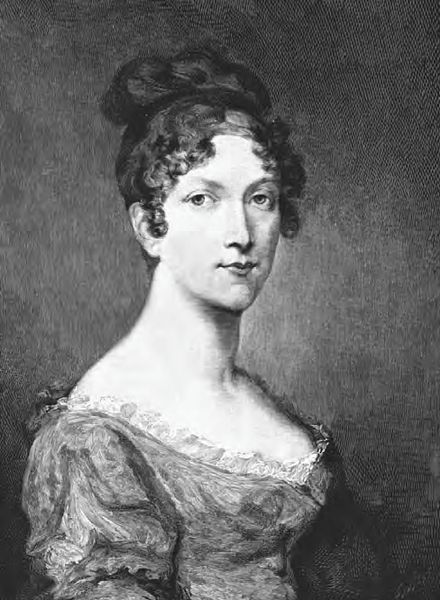
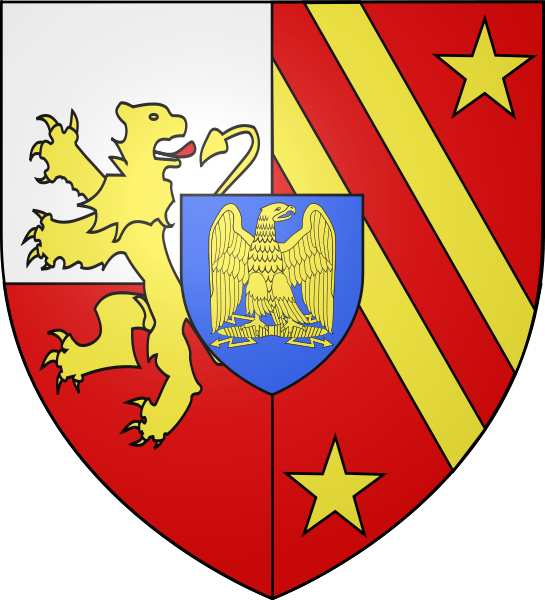
Maria Anna (Marie Anne) Elisa Bonaparte Baciocchi Levoy, Princesse Française, Duchess of Lucca and Princess of Piombino, Grand Duchess of Tuscany, Countess of Compignano (3 January 1777 – 7 August 1820) was the fourth surviving child and eldest surviving daughter of Carlo Buonaparte and Letizia Ramolino, making her the younger sister of Napoleon Bonaparte. Her other elder siblings were Joseph and Lucien, whilst her younger siblings were Louis, Pauline, Caroline and Jerome.
As
princess of Piombino and Lucca, then grand duchess of Tuscany, she was
his only sister to possess real political power, though her sharp
tongue often caused troubles in her relations with him. Highly
interested in the arts, particularly the theatre, she encouraged them
in the territories over which she ruled. Élisa was born in Ajaccio, Corsica.
She was christened Maria - Anna but later adopted the nickname
Élisa as her official name (it was originally given to her as a
nickname by her brother Lucien, to whom she became very close in
childhood). In June 1784, a bursary allowed her to attend the Maison royale de Saint - Louis at Saint - Cyr, where she was frequently visited by her brother Napoleon during her studies. The Legislative Assembly decreed the Maison's closure on 16 August 1792 and Élisa left on 1 September to be taken back to Ajaccio by Napoleon. Around 1795, the Bonaparte family set up home in Marseille,
where Élisa got to know Pasquale Baciocchi Levoy, who later
changed his name to Félix Baciocchi Levoy (1762 – 1841). A
Corsican nobleman who had formerly been a captain in the Royal Corse, he had been dismissed from his rank upon the French Revolution. He and Élisa married in a civil ceremony in Marseille on 1 August 1797 then in a religious ceremony in Mombello,
where Napoleon had a villa and to which he had moved his family in June
1797. The religious ceremony went ahead, on the same day as her sister Pauline's marriage to general Victor - Emmanuel Leclerc, despite Napoleon's initial reservations as to Élisa's choice, since Félix had a reputation as a poor captain. In
July Félix was promoted to chef de bataillon, with the command
of the citadel at Ajaccio. In 1799, the Bonaparte family moved to Paris, with Élisa setting up home at 125 rue de Miromesnil, in the quartier du Roule, where she held receptions and put on plays. On the rise of the Consulate, she and her brother Lucien held an artistic and literary salon at the hôtel de Brissac, at which she met the journalist Louis de Fontanes, with whom she had a deep friendship for several years. On 14 May 1800, on the death of Lucien's first wife, Christine Boyer, Élisa took Lucien's two daughters under her protection, placing the eldest, Charlotte, in Madame Campan's boarding school for young women at Saint - Germain - en - Laye. At the start of November 1800, Lucien had to leave his job as minister of the interior and was sent to Madrid as French ambassador to the court of the king of Spain,
with Élisa's husband Felice Baciochi as his secretary.
Élisa remained in Paris, but kept up a regular correspondence
with her brother. On 18 May, the French Senate voted in favour of setting up the First French Empire,
and Élisa and Napoleon's other sisters were established as
members of the Imperial family, taking the title "Altesse
impériale" ("Imperial Highness"), with Felice Baciocchi being promoted to général de brigade and then made a senator. Her
separation from her husband in 1805 was seen favorably by Napoleon
(though on her promotion to Lucca he soon rejoined her). On 19 March
1805, Napoleon awarded her the Principality of Piombino, which had been French property for some years and was of major strategic interest to Napoleon due to its proximity to Elba and Corsica.
Felice and Élisa took the titles of prince and princess of
Piombino. In June 1805 the oligarchic republic of Lucca (occupied by
France since late 1799) was turned into a principality and added to
Felice and Élisa's domain, with their entry into Lucca and
investiture ceremony following on 14 July 1805. Napoleon
had contemptously called Lucca the "dwarf Republic", due to its small
size in terms of territory, but despite this it was a bulwark of
political, religious and commercial independence. Most of the power
over Lucca and Piombino was exercised by Élisa, with
Félix taking only a minor role and contenting himself with only
taking military decisions. The inhabitants of Lucca, under French
occupation and grudging the loss of their independence, knew Elisa
ironically as "la Madame" and had little sympathy for Napoleon, Elisa
or their attempts to "Frenchify" the republic. Very
active and concerned with administering the area, she was surrounded at
Lucca by ministers who largely remained in place right to the end of
her reign. These ministers included her minister of justice Luigi
Matteucci, her minister of the interior and foreign affairs Francesco
Belluomini (replaced in October 1807 by his son Giuseppe), her finance
ministers Jean - Baptiste Froussard (head of the cabinet) and later
Pierre d'Hautmesnil (with the budget portfolio). She also set up a
court and court étiquette inspired by those at the Tuileries. On
31 March 1806 Napoleon withdrew Massa and Carrara from the kingdom of
Italy to add to Élisa's possessions. Carrara was one of the
biggest white marble suppliers in Europe and Élisa bolstered her
prestige by establishing an Académie des Beaux - Arts designed to
host the greatest sculptors and thus make Carrara an exporter of marble
statues, which had a greater value than the raw marble. She also set up
the Banque Élisienne to give financial aid to sculptors and
workers on marble taxes. She reformed the clergy at Lucca and Piombino
from May 1806, during which reforms she nationalised their goods and
lands and closed down convents which did not also function as hotels or
schools. She also carried out legislative reform in Lucca, producing laws inspired by the Code Napoleon (such
as the notable "Codice rurale del Principato di Piombino", issued on 24
March 1808) and producing a new penal code which was promulgated in
1807 and first reformed in 1810. In
1807 she set up the Committee of Public Charity for distributing
charity funds, made up of clergy and lay people, and also instituted
free medical consultations for the poor so as to eradicate the diseases
then ravaging Lucca's population. She demolished Piombino's hospital to
build a new one in the former monastery of San Anastasia, with the new
building opening in 1810, and also set up the Casa Sanitaria, a
dispensary in the town's port. On 5 May 1807 decreed the establishment
of
the Committee for the Encouragement of Agriculture, Arts and Commerce
to encourage and finance the invention of new machines and new
techniques to increase the territories' agricultural production and
experimental plantations such as those of mulberries at Massa, where an
École Normale de la Soie (Silk School) was created on 16 August
1808. Élisa
also set up many teaching establishments in Lucca and, in 1809, a
Direction Générale de l'Instruction Publique (General
Department of Public Education). On 1 December 1807 she set up the
Collège Félix, the only boys' secondary school in the
principality. For girls, she began by fixing set curricula for convents
that also operated as schools, then set up a body of "dames
d'inspection" to verify that these curricula were being adhered to.
Teaching of girls aged 5 to 8 was made compulsory, though the laws were
not always well applied. On 2 July 1807 Élisa founded the
Institut Élisa within the limits of a former convent for
noble born girls, to produce well educated and cultivated future wives.
On 29 July 1812 Élisa set up an establishment for young poor
girls, the Congregazione San Felice, though this did not long outlive
Élisa's fall. As
with Napoleon, Élisa set up city improvement works in her
territories, mainly to expand the princely palaces. These works were
hotly contested, especially in Lucca, where the expansion of the
princely palaces necessitated the demolition of the church of San
Pietro in March 1807. She also razed an entire block in Lucca to build
a piazza in the French style in front of her city residence (now the
seat of the province and the prefecture). That block had included the
church of San Paolo with the venerated image of the Madonna dei miracoli and so its demolition seriously affected the city's medieval architecture and almost sparked a revolt. At
Massa, she demolished a cathedral on 30 April 1807. The palace at Lucca
was fully redecorated and the gardens improved, with the creation of a
botanical garden with a menagerie and aviary in 1811. She also began
road construction, notably the "route Friedland" to link Massa and
Carrara, with work beginning on 15 August 1807 but becoming delayed and
only completed in 1820. Lucca's status as a spa town was also bolstered
by her improvement of the architecture and decor of the town's baths.
She began construction of an aqueduct into Lucca in 1811, but this too
was only completed after her fall. On 21 March 1801 Lucien Bonaparte and the king of Spain had signed the Treaty of San Ildefonso, which restored Louisiana to France and in exchange established the kingdom of Etruria by dividing Tuscany. The new kingdom was initially put in the charge of the infante Maria Louisa and her husband Louis,
but he rapidly proved to be a poor ruler and was also soon widowed.
Thus, on 29 October 1807, Napoleon signed the treaty of Fontainebleau
with the Spanish court. This transferred Tuscany to France and in
November that year Marie - Louise left the kingdom. From 12 May 1808
Tuscany was entrusted to an intermediary governor Abdallah Jacques
Menou, a French soldier who had converted to Islam during Napoleon's invasion of Egypt,
but his way of life and lack of interest in the territory's affairs
forced Napoleon to recall him on 5 April 1809. From 1808 Élisa
has wished to become governor of Tuscany, but at the end of that year
an illness temporarily prevented her from taking part in state affairs.
She recovered in February 1809 and on 2 and 3 March that year a decree
officially created the grand duchy of Tuscany and made Florence its
capital and Élisa its grand duchess, with Félix being
promoted to général de division. However, unlike her
relative autonomy in Lucca and Piomobino, in Tuscany Élisa was
ordered to enforce the decisions of Napoleon and his ministers with no
power to modify those decisions. On
2 April 1809 Élisa arrived in Florence, where she was coldly
received by the nobility, the more so since her arrival coincided with
a revolt against compulsory conscription, in the course of which a
mayor and a judge were assassinated. That conscription and the many new
taxes imposed on Tuscany by Napoleon both proved the source of many
conflicts in the region. As at Lucca, Élisa tried to nationalise
the goods of the clergy and closed many convents. The first two volumes
of the "Annali del Museo Imperiale di Fisica e Storia Naturale" of
Florence were dedicated to her, in 1808 and 1809 - the observatory at
that museum of physics and natural history was the ancestor of
Florence's present day Osservatorio Astrofisico di Arcetri. Élisa also got caught up in Napoleon's removal of pope Pius VII.
Pius had opposed the Empire's annexation of the Papal States, refused
to renounce his temporal powers and excommunicated Napoleon in the bull Quum memoranda on 10 June 1809, and so Napoleon put general Étienne Radet in
charge of removing the pope and thus the opposition he was arousing
against Napoleon. The removal occurred on the night of 6 July 1809 and
in the following days took the pope towards Savona,
passing by Florence, where Élisa not only did not welcome the
pope in person but also asked his kidnappers to get out of the area as
soon as possible, so as not to displease her brother by welcoming his
enemy too comfortably or too long. Élisa's
relations with Napoleon were already becoming more and more strained,
with Napoleon frequently recalling her for any irregularity in her
execution of his orders in Tuscany. On 17 March 1810, Élisa
arrived in Paris for Napoleon's marriage to Marie - Louise of Austria,
but Napoleon took advantage of this to reclaim the payments from his
grants of Massa and Carrara. Returning to Tuscany, she found Napoleon
still claiming these payments via his envoys but refused to pay them,
arguing that the territories had too few resources to pay (Napoleon was
claiming 200,000 lira). He thus threatened to take Carrara back from
her and in May 1811 also demanded conscription in Lucca, which had
previously been spared this. On returning to Lucca from Florence did
not find herself welcome. Back in Lucca, she restored the villa now
known as the Villa Reale di Marlia. In 1813, with Napoleon facing the allied coalition after his Russian campaign, Caroline Bonaparte's husband Joachim Murat,
king of Naples, put the defence of his subjects over support for his
brother in law and split from him to join the Austrian forces. The
Neapolitans marched on Rome and on 1 February 1814 Élisa had to
abdicate her title as Grand Duchess on the restoration of Grand Duke Ferdinand III and leave Tuscany for Lucca. In March, the Neapolitans captured Massa and Carrara and the Anglo - Austrian forces under Lord William Bentinck captured Lucca,
forcing the pregnant Élisa to flee on the night of 13 March
1814. She made several short stays in Italy and France, notably seeking
support in Marseille for her to be able to return to Italy as a private
individual. Those requests were denied and she was able to stay in
Austria for a time thanks to her brother Jérôme Bonaparte before moving to the Villa Caprara in Trieste. Napoleon
was exiled to Elba on 1 March 1815 and Élisa was arrested on 25
March before being interned in the fortress of Brünn in Austria.
At the end of August, she was freed and authorised to stay in Trieste
with the title of countess of Compignano. She then acquired a country
house at Villa Vicentina near Cervignano and
began financing archaeological digs in the region. In June 1820 she
contracted a fatal illness, probably on an excavation site, and died on
7 August aged 43, becoming the only adult sibling of Napoleon Bonaparte who did not survive him. She was buried in the San Petronio Basilica of Bologna. She married Felice Pasquale Baciocchi Levoy, a member of Corsican nobility,
on 1 May 1797, created Prince Français, Duke of Lucca and Prince
of Piombino and Prince of Massa - Carrara and La Garfagnana. They were
parents of four children.
